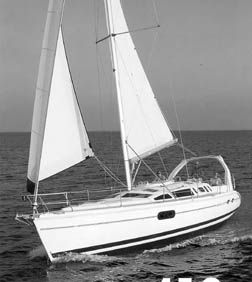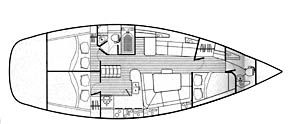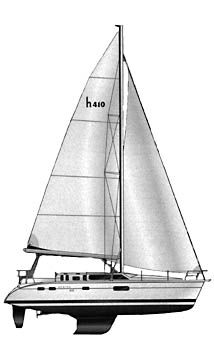Since entering the boatbuilding business with a 25-footer that debuted in 1977, Hunter Marine now is one of the two largest sailboat builders in the US (Catalina, of course, is the other).
Focusing on buyers new to the sport, those stepping up from daysailers, and on selling boats to the Caribbean charter operators, its current line ranges in size from 9 to 50 feet.
The company produces more than 1,200 boats annually at a 200,000-square-foot facility in Florida, and has 140 dealers worldwide. It was converted to an employee-owned operation in 1996, and currently operates under the direction of Dan Jett, president.
Design
Hunter’s in-house design team draws lines for a fleet of yachts bearing a striking similarity to one another. The common denominators are generous beam with rounded shapes and large living areas belowdecks; the boats are designed and constructed for daysailing and coastal cruising.

The 410, however, is marketed as an offshore cruiser, and apparently is striking a chord with customers, certainly those looking for value.
Unlike the chubbier Hunter 320 (PS, October 1, 2000), which one owner described as “looking as though someone blew into the exhaust pipe until it was round,” the 410 presents a sleeker, lower profile reminiscent of Thursday’s Child, a 60-footer that company founder Warren Luhrs sailed on a record-breaking trip from New York to San Francisco.
The bow is nearly plum; entry angle is 14°. The sheer line is straighter, though this model shares the same rounded stern profile as her sisters, a characteristic accentuated by a rubrail around the hull that conceals the hull-deck joint. Freeboard at maximum beam is 50″. Long, slender black ports on the cabin side and narrow recessed ports near the bow produce the illusion of forward movement.
Length overall is 40′ 8″, waterline length is 37′ 10″, and displacement with the 6,700-lb. fin keel version is 19,500 lbs. A shoal draft keel drawing 5′ 0″ is an option.
The sail plan includes a high aspect ratio mainsail designed to carry a full roach, and seven-eighths fractional rig; mast height is 58′ 5″, and sail area is 823 square feet with a 100% jib.
The sail area/displacement ratio (SA/D) is 18.2, and the displacement/length (D/L) ratio is 161, light for long-distance cruising, if only because stowage will be limited.
Like other Hunters, the 410 has an “integrated arch” spanning the cockpit that serves as a mount for the mainsail traveler and sail controls; it’s a highly efficient arrangement that reduces cockpit clutter. It is a strong style statement that has much effect on the boat’s looks. These were originally molded fiberglass but now are fabricated from stainless steel.
Construction
Hunter told PS that the lay-up process and schedule are classified by the International Marine Certification Institute as a Category A yacht suitable for “unlimited offshore use.”
Following application of a coat of vinylester resin intended to provide blister resistance, the hull below the waterline is constructed of solid fiberglass—alternating layers of 24-ounce mat and roving. Areas surrounding the keel, mast step and rudder are reinforced with additional layers of fiberglass; the bottom of the hull, Hunter said, is 1″ thick. Topsides are cored with balsa.
A similar schedule is followed for construction of the deck, except that coring is marine-grade plywood.
The hull-deck joint is an outward flange bonded with 3M 5200 and fastened with stainless steel bolts and nuts on 6″ centers. Areas in which winches, stanchions and hardware are installed are reinforced with aluminum backing plates between layers of mat and roving, and additional layers of fiberglass. (This also applies to the Hunter 320, which we erroneously reported as having no backing plates.)
The interior is constructed of fiberglass pans designed to stabilize the hull while defining living spaces; they are tabbed to the hull with fiberglass tape.
This production scheme lends itself to mass production because it is less time consuming and less expensive than methods employed by the builders of higher priced boats, which include assembling berths and cabinets from individual pieces of wood.
Deck Layout
The combination of deck and cockpit arrangement, and integrated arch, reflects the builder’s intent to create a yacht that doubles as an entertainment center.
The footwell, for example, in the circular cockpit measures 6′ 2″ athwartships and 5′ 1″ on the centerline, for example. Seats measuring 15″ wide are 16″ above the sole and ergonomic backrests are 12″ tall. The area comfortably seats eight adults. The space is nearly free of sheets and lines. The diamond-shaped non-skid, which is also molded in the coaming, is excellent.

Storage is in lazarettes ranging in size from 26″-48″ long and 16″-32″ deep; the combination is adequate for storage of a spinnaker, dock lines and fenders, and the sailing gear necessary for distance cruising. Two additional storage areas are located on the swim platform.
The helmsman’s seat is located on the center of the transom, which also provides access to a swim platform, and additional seating is on curved teak seats on the stern pulpit.
The 44″ destroyer-type wheel is mounted on a molded pedestal into which is integrated a fold-down table with two leaves. The pedestal includes space for a well-arranged navigational pod that includes compass, VHF radio and radar display. Engine controls located on the port side of the arch are within easy reach of the helmsman.
We give the designers high marks for the 19″ x 21″ seat at the top of the companionway that, when outfitted with a spray dodger, provides a lone watchman with a protected seat out of the elements.
The 410 has more winches as standard equipment than other models. Primary winches for the mainsheet are Lewmar 44 self-tailers. Aluminum Schaefer sail track is located atop the doghouse and jib sheets are led to Schaefer blocks and Lewmar 48 self-tailers. A recessed well located near the winches provides a storage area for halyards and sheets, a good touch. A Lewmar 16 self-tailer controls the furler, which may be a Profurl or Furlex.
The arch and Harken traveler arrangement are similar to that on the 320. The traveler controls are led inside the arch exit boxes that are accessible to the helmsman; the mainsheet is housed inside the boom, led forward to the mast and aft to Spinlock XT sheet stoppers.
During our test sail, all of the sail handling gear was adequate to the task.
The 410 features a double spreader B & R rig with shrouds organized in a diamond-shaped pattern. Standing rigging is 3/16″-5/16″ 1 x 19 wire.
Hunter claims that the B & R rig accomplishes three objectives: Increased support for the mast, elimination of a permanent backstay, and ability to carry a full roach mainsail that produces better performance and sail shape than a traditional mainsail.
The significant difference between this and a conventional rig is the addition of two stainless steel struts port and starboard. The inboard ends are attached to the mast just above the boom, and the outboard ends are attached to chainplates in common with the lower shrouds. Hunter claims that the strut stabilizes the lower section of the mast and creates a strong point for boom and spinnaker pole loading.
Between the spreaders are two pairs of shrouds in an X shape; one shroud is led from the outboard end of a spreader up to the mast, and a second is led from the mast up to the outboard end of a spreader. Upper shrouds are led outboard to the rail.
Spreaders are swept aft 30°; designers claim they will produce 11.5° sheeting angles and improve upwind performance. They do, however, prevent letting the boom out all the way.
The rest of the deck arrangement is conventional: Bow pulpit with 25″ double rails, 24″ lifelines running bow to stern, and a 1″ fiberglass toerail. One stainless steel handrail is located at the front of the cabin; we would consider the addition of a second farther aft. The side decks are 16″ wide. With the outboard placement of shrouds, movement forward is essentially unimpeded.
The boat was obviously designed for use in warm climates, as evidenced by a total of eight opening deck hatches and 11 opening ports ranging in size from 4″ x 10″ to a bow hatch measuring 20″ square. Air conditioning is offered as optional equipment. Combined with large fixed portlights recessed into the hull, the interior has excellent fresh air circulation and light.
Accommodations
The 410 is offered in two models.
The “Owner’s version” has a large aft stateroom with athwartship queen-size berth. The “Tri-cabin option,” which appears to be designed for the charter industry, has two identical aft staterooms with 76″ x 58″ fore-and-aft berths. Cushions are 7″ thick. Both models have two heads, one aft and one forward of the offset double berth.

The galley is to starboard at the foot of the companionway, opposite the second head. The nav station and a settee that could double as a single berth are located to port. The U-shaped dinette, convertible to a double berth, is to starboard.
The interior plan keeps well in mind the sailor who likes to entertain. The saloon, with 6′ 2″ headroom, is accented by a teak and holly sole, teak bulkheads, Corian countertops, a stainless steel mast compression post, stainless steel handrail at the front edge of the galley, tufted upholstery and a white liner. Two storage cabinets on each side of the boat and a small shelf provide the only storage areas in the saloon (other than the usual spaces below the settees and floorboards). Consequently, there’s a whopping 9′ between port and starboard cushions.
The engine is enclosed behind removable panels located amidships in the two staterooms. Removing the panels and companionway steps gives 270° access to the standard 50-hp. Yanmar.
The L-shaped galley is well organized with a 24″ x 54″ counter, refrigerator/freezer, 18″ x 8″ microwave, double stainless steel sink, and gimbaled three-burner Princess stove, which abuts the aft bulkhead. Cabinetry is mounted on the hull outboard of working surfaces. Additional storage is in drawers near the sink.
The head, 44″ at its widest point and 41″ long, is accessed from the port stateroom or saloon. It is outfitted with a teardrop sink, Jabsco toilet and shower stall. The shower is smallish at only 20″x 22 “. It is well ventilated by two opening portlights.
The saloon benefits from four 8″ x 13″ ports built into the hull that provide an important outside view.
Navigational chores are performed on a contoured seat at a generous table that provides a 22″ x 33″ work surface. Storage is below the seat and in a 4″ deep chart table.
Spaces on the hull and bulkhead are large enough to house an electrical panel and, on our test boat, a radar unit, single-sideband (SSB) radio, chartplotter, VHF radio and stereo system, all within easy reach of the navigator.
The dining table, which measures 31″ x 46″, is designed to seat four adults; a silverware compartment is located in the middle of the table.
When lowered, the table makes a 48″ x 78″ double berth; counting the port settee, the tri-cabin version sleeps nine persons. Two lee boards provide a level of safety for crew sleeping amidships, though on our test boat they did not fit properly and produced an irritating rattle.
In the three-cabin model odds are that the forward stateroom will be appropriated by the skipper, owing to its private head and small vanity. The offset berth to starboard is only 43″ wide, about the size of a double bed, and 74” long. Small open storage shelves, a hanging locker and cabinet with two shelves, and four cedar drawers below the berth provide the only storage. The head is far forward, which in any kind of sea will make for an interesting ride! The shower head is located atop a molded fiberglass pan that on our test boat was separating from the hull.
Performance
We tested the 410 on San Francisco Bay in conditions that ranged from flat seas and 5 knots of wind to choppy seas and a 15-knot northwesterly. She performed well in both conditions, and gave us a comfortable ride.
In apparent wind speeds under 10 knots she sailed at 4-5 knots. When we tried to sail her above 35°-40° apparent wind angle, however, we nearly stalled; the boat also tended to hobbyhorse. Fortunately, when we footed off 5° she quickly accelerated from the stall.
Similarly, once wind speeds reached 15 knots and we footed off to 40°-45° apparent, she plowed easily through the chop with speeds reaching 5.5-6 knots. The helm was surprisingly light, though we were heeled approximately 15°.
Sailing on a tight reach at 60° apparent, with full main and 100% jib, boat speed exceeded 7 knots. Footing off to 90° produced an immediate 3/4- to 1-knot increase in speed. With the rail buried and spray covering the bow she remained easy to sail and comfortable.
Though holding a steady course in 20 knots of wind in confused 4-foot seas was more difficult, the helm remained manageable and the ride became a romp. The ride would have been more comfortable with shortened sail.
Conclusion
We think the 410 has more eye appeal than its rounder sisters. It also demonstrates the benefits of a 41′ boat over a 35’—the additional length produces more speed, and, combined with beam, correspondingly larger living spaces.
Construction is typical of Hunter and similar to that of its chief competition—Catalina and Beneteau. Our primary criticism is the use of pans and liners that may be susceptible to breakdowns in adhesion under continued stress and torquing experienced in heavy seas on long passages. Most other production builders use them, too, because they save time and money. Pans lead to our second concern, and that is minimal stowage.
The company receives high marks for post-sale service from customers and dealers. Two dealers who discontinued relationships with other production manufacturers in favor of Hunter now have two years of experience with the company; they both say that post-sale service and warranty work are completed with few hassles. They also told PS that Hunter owners are a loyal bunch aware of the potential tradeoffs between their boats and those that are higher priced.
They also say that the boats are not as well built or finely finished as higher-priced boats like Sabre and Tartan. Price, of course, is much less, at $172,000, compared to the Tartan 4100, reviewed in the November 1, 2000 issue, at $245,000.
We feel the 410 performs as well as her primary competitors, and was easy to maneuver in the tight quarters of the marina. Living spaces are large enough, and well outfitted, so will be functional on cruises and comfortable on rainy days.
Also With This Article
Click here to view At A Glance.
Contact- Hunter Marine Corp., Box 1030, Rt. 441, Alachua, Florida, 32616;904/462-3077.
































